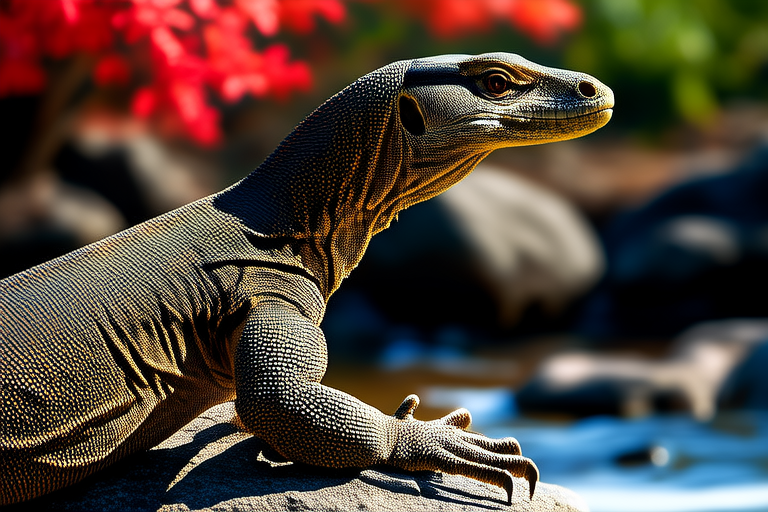A Closer Look at the Majestic Water Monitor: Care, Diet, and Habitat Insights
The water monitor (Varanus salvator) is one of the largest lizards in the world, captivating reptile enthusiasts with its impressive size, agility, and unique behaviors. Native to Southeast Asia, these creatures are known for their adaptability and ability to thrive in diverse environments. This article delves into the intricacies of caring for water monitors, exploring their dietary needs, habitat preferences, and essential care requirements.
Care Requirements for Water Monitors
Housing
Providing adequate housing is paramount when caring for a water monitor. Due to their size and active nature, they require spacious enclosures that allow for ample movement. A juvenile monitor can be housed in a 4′ x 2′ enclosure, but as they grow, larger spaces are necessary, often exceeding 8′ x 4′. Glass terrariums are not recommended due to the potential for heat buildup and lack of ventilation. Instead, custom-built wooden enclosures with mesh tops are ideal. These enclosures should be designed with safety in mind, ensuring no gaps or weak points where the monitor could escape.
Temperature and Lighting
Water monitors are ectothermic, meaning they rely on external sources of heat to regulate their body temperature. Maintaining an appropriate thermal gradient is crucial for their health and well-being. The enclosure should have a basking area that reaches around 95°F (35°C) and a cooler area that remains between 75-80°F (24-27°C). Nighttime temperatures should drop slightly to between 72-75°F (22-24°C).
UVB lighting is also essential for water monitors, as it aids in calcium absorption and overall health. A 10% UVB output is recommended, and the light source should be placed within 12-18 inches of the basking area. Ensure that the UVB bulbs are replaced every six months, even if they appear to still be functioning, as the UVB output diminishes over time.
Humidity
Maintaining proper humidity levels is vital for water monitors, as they originate from tropical regions with high humidity. The enclosure should be kept at 60-80% humidity, which can be achieved through misting systems, humidifiers, and substrate that retains moisture. It’s important to provide a water dish large enough for the monitor to soak in, as this helps maintain hydration and skin health.
Dietary Needs of Water Monitors
Natural Prey and Nutritional Requirements
In the wild, water monitors are opportunistic predators, feeding on a wide variety of prey items. Their diet consists of fish, frogs, insects, small mammals, birds, and even carrion. Captive water monitors should be provided with a similarly diverse diet to ensure they receive all necessary nutrients. High-quality commercial diets, such as pre-killed mice and rats, should form the core of their diet, supplemented with feeder insects like crickets, dubia roaches, and mealworms.
Supplements are essential to prevent nutritional deficiencies. Calcium and vitamin D3 supplements should be dusted onto prey items regularly, while multivitamin supplements can be offered less frequently. It’s important to balance supplementation to avoid overdosing, which can lead to health issues.
Feeding Frequency
Younger water monitors have higher metabolisms and require more frequent feedings, typically every 2-3 days. As they mature, feeding frequency can decrease to every 4-5 days. The amount fed should be proportional to the monitor’s size, with meals roughly equivalent to the size of the monitor’s head.
Suitable Habitats
Wild Habitats
Water monitors are highly adaptable and can be found in a variety of habitats, including mangrove swamps, forests, grasslands, and near freshwater bodies such as rivers, lakes, and ponds. They are excellent swimmers and spend considerable time in the water, where they hunt for fish and amphibians. Their adaptability allows them to thrive in diverse environments, from dense jungles to open fields.
Captivity Habitats
Creating a suitable captive habitat for a water monitor requires careful consideration. In addition to the spacious enclosure mentioned earlier, it’s important to include climbing structures, such as branches and logs, as well as swimming areas. Water monitors are strong climbers and swimmers, so providing opportunities for both activities is crucial for their physical and mental stimulation.
Substrate choices are also important. While some keepers use reptile carpet or newspaper, many prefer substrates like coconut fiber or cypress mulch, which retain moisture and provide a more natural environment. However, caution must be taken to avoid ingestion of substrate, which can lead to impaction. Providing a separate feeding area can help minimize this risk.
Interesting Facts and Anecdotes
Water monitors are not only fascinating in terms of their care but also in their behavior and biology. For instance, they have keen eyesight and a remarkable sense of smell, which they use to locate prey. One interesting fact is that water monitors can hold their breath underwater for up to 30 minutes, allowing them to ambush prey effectively. Additionally, they are known for their intelligence and have been observed using tools, such as sticks, to dig for food.
Another intriguing aspect of water monitors is their social behavior. While they are generally solitary animals, there have been reports of water monitors living harmoniously in groups in certain regions. These groups may consist of several individuals, sharing resources and even engaging in cooperative hunting.
Conclusion
Caring for a water monitor is a rewarding yet challenging endeavor. With their unique needs and impressive capabilities, these lizards offer a glimpse into the wonders of the animal kingdom. By understanding their care requirements, dietary needs, and habitat preferences, reptile enthusiasts can provide their water monitors with a thriving environment. Whether you’re a novice or an experienced owner, the journey of caring for a water monitor promises endless fascination and discovery.
